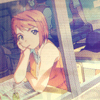
Graphic novels/comics:
Kaplan, Bruce Eric: Edmund and Rosemary Go to Hell
(modern teens are all drug-addicted multi-taskers! Oooh, what bold and inventive social satire. I'm breathless. Memo to Mr. Kaplan: develop a sense of history).
Martinson, Lars: Tonoharu
(AET=JET, I presume, or something functionally identical. This book is kind of funny because I can compare it to Mikkeneko's JET stories. Mikke experienced some of the same issues--language difficulties, awkwardness adapting to Japanese workplace mores, living in the boonies--but as Mikke is A) a real close personal friend, B) not a close-minded, lazy, socially maladjusted twit, and C) also talks about stuff she likes about living and working in Japan, I prefer her stories . Nevertheless, this entertains me, and I'll read more).
Fraction, Matt, writer, Steven Sanders, artist: The Five Fists of Science
(damned silly, but fun. I'm also reading The Devil in the White City at the moment, and I must say, the late nineteenth century was a fascinating period in American history. We sort of skidded through it in my high school American history class, trying to catch up to WWI; I had no idea how much I was missing. Like how Mark Twain and Nicola Tesla built giant robots and J.P. Morgan summoned dark beasts of hell into New York. We definitely skipped that part).
Tetzner, Lisa, writer, Hannes Binder, artist: The Black Brothers
(what a weird hybrid of a story this is! I wish it had more detailed editor's notes on tis creation, since judging by the original publication date--1940--and the date of the birth of the artist--1947--the writing and the illustrations were created independently. Judging by the weird gaps in the text, parts of the story are intended to be told through the illustrations, but they're not consistent or coherent, and it ends up being jerky and confusing. An interesting oddity, but to my mind, not an impressive one).
SOME STUFF I LOVED: all three of the following are highly recommended; I actually read them all in a row and got up and sort of shook the one I'd just finished around in the air, crying, "These comics are so good! I love that these comics are so good! Oh my god!" Yes, really. I get excited about good art.
Briggs, Raymond: Ethel and Ernest
(Briggs' graphic history of his parents' marriage, spanning the 1930s through 1971. It's lovely, kind, affectionate, revealing...gorgeously colored art, with a sense of intimacy, and Briggs is a guy who--unlike Kaplan up there--has a sense of history. The damn thing made me cry, not out of tragedy--Mother Come Home is a tragedy that didn't make me cry, although I don't think it wanted me to--but this made me cry because it is so familial and full of human life and honesty. Life is beautiful).
Hornschemeier, Paul: Mother Come Home
(In a review blurb on the back, Craig Thompson calls this Formalist. I need to look up what that means, because I see it often in comics discussion, but have only a vague idea of its proper meaning. But, um, anyway, this is a sort of stunning work of tragedy which I do not want to explain, because it unfolds itself perfectly without the reader needing an explanation. I really don't know what to say except that Hornschemeier is brilliant).
Kuper, Peter: Sticks and Stones
(another brilliant, vivacious wordless graphic novel without any damned woodcuts. Kuper's drawings are bold and visually interesting; the actions and meanings are perfectly clear. He paces well and knows how to achieve impact; he can achieve emotional depth without sentimentality. This is really one of the niftiest fables about wars of colonization I've read in quite some time).
Manga:
Koike Kazuo, writer, Kojima Goseki, artist: Lone Wolf and Cub vol. 3.